- Home
- >
- Dice probability – Explanation & Examples
JUMP TO TOPIC
Dice Probability – Explanation & Examples
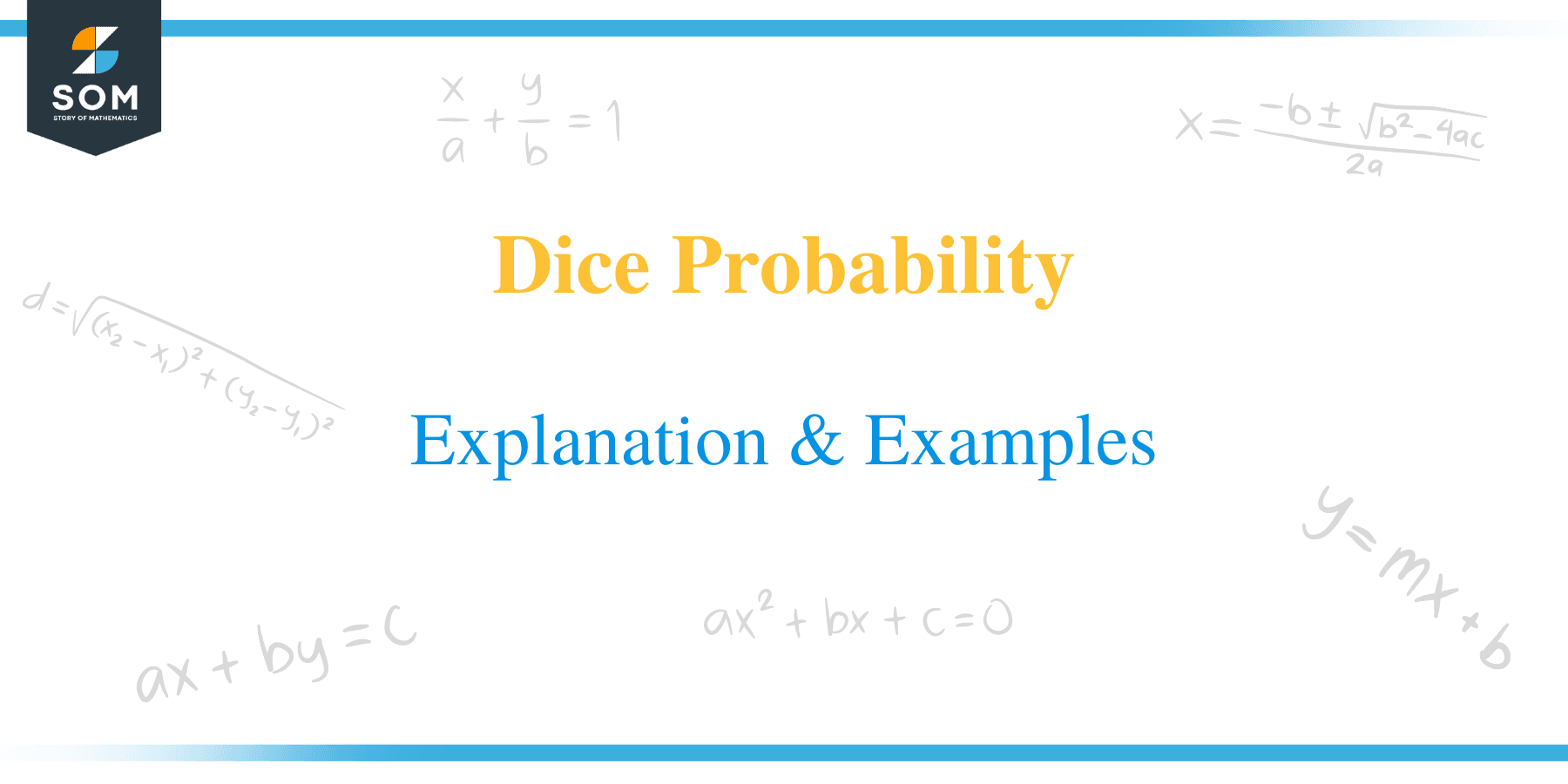 The origins of probability theory are closely related to the analysis of games of chance. The foundations of modern probability theory can be traced back to Blaise Pascal and Pierre de Fermat’s correspondence on understanding certain probabilities associated with rolls of dice. It is no wonder then that dice probabilities play an important role in understanding the probability theory.Dice probabilities refer to calculating the probabilities of events related to a single or multiple rolls of a fair die (mostly with six sides). In a fair die, each side is equally likely to appear in any single roll.
The origins of probability theory are closely related to the analysis of games of chance. The foundations of modern probability theory can be traced back to Blaise Pascal and Pierre de Fermat’s correspondence on understanding certain probabilities associated with rolls of dice. It is no wonder then that dice probabilities play an important role in understanding the probability theory.Dice probabilities refer to calculating the probabilities of events related to a single or multiple rolls of a fair die (mostly with six sides). In a fair die, each side is equally likely to appear in any single roll.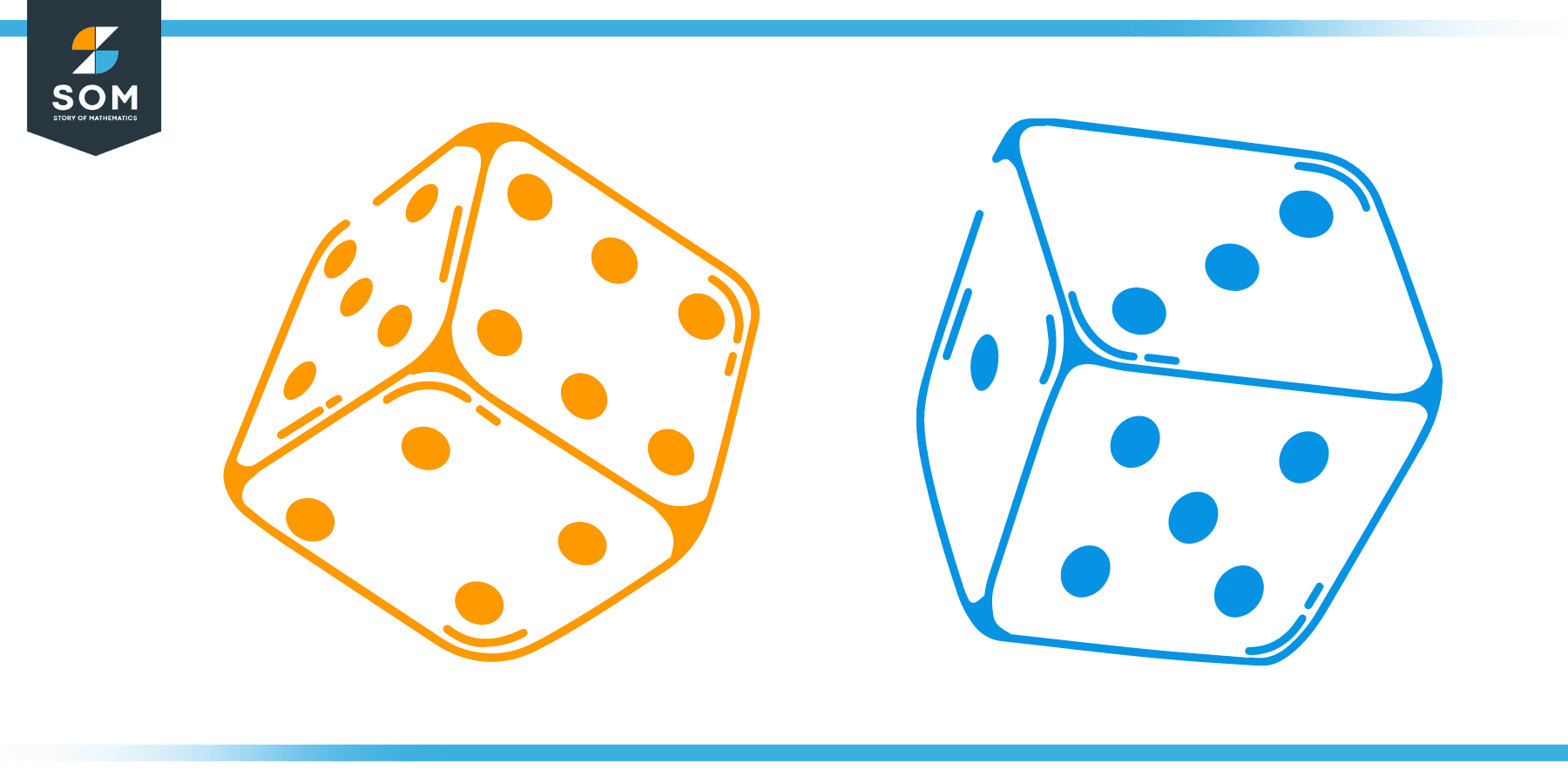 To get a better understanding of dice probabilities discussed in this article, it might be a good idea to refresh the following topics:
After reading this article, you should understand the following concepts:
To get a better understanding of dice probabilities discussed in this article, it might be a good idea to refresh the following topics:
After reading this article, you should understand the following concepts:- What are dice probabilities?
- How to calculate dice probabilities of single/multiple rolls using sample space method.
- How to calculate dice probabilities of multiple rolls using the concept of independent events.
- How to calculate dice probabilities of multiple rolls using tree diagrams.
How to calculate dice probability:
To calculate dice probabilities, whether a single or multiple rolls, we first need to understand how to make sample spaces.Sample space:
A sample space is the collection of all possible outcomes. For example, when we roll a six-sided fair die, there are six possible outcomes, so the sample space is given as $\text{S}=\{1,2,3,4,5,6\}$. If each outcome in the sample space is equally likely, then the probability of a single outcome is given as$\text{Probability of an outcome} = \frac{1}{\text{Total number of outcomes in the sample space}} $So, if we roll a die, the probability of getting any one number between $1$ and $6$ is equal to $\frac{1}{6}$.Any subset of the sample space is called an event. For example, let us consider $E=\{2,4,6\}$, which is a subset of sample space $S $ and it contains only even numbers. We can calculate the probability of an event as$P(E) =\frac{ \text{number of elements in E}}{\text{ Total elements in S}}$
So, the probability of getting an even number when we roll a fair die is given as$P(\text{getting an even number}) = P(E) = \frac{3}{6} = \frac{1}{2}$.Similarly, we calculate the probability of any event (i.e., a subset of $S$), as shown in the examples below:Example1: What is the probability of getting a number >$4$, when a fair six-sided die is rolled.Solution:We can write the sample space as $\text{S}=\{1,2,3,4,5,6\}$. Let $E$ be the event that number is greater than $4$, then $E=\{5,6\}$. Hence,$P(\textrm{Number} > 4) = P(E) = \frac{\textrm{Number of elements in E}}{\textrm{Number of elements in S}} = \frac{2}{6} = \frac{1}{3}$.Example 2: What is the probability of getting a prime number when a fair six-sided die is rolled.Solution:We can write the sample space as $\text{S}=\{1,2,3,4,5,6\}$. Let $E$ be the event that the number is prime, then $E=\{1,3,5\}$. Hence,$P(\textrm{PrimeNumber}) = P(E) = \frac{\textrm{Number of elements in E}}{\textrm{Number of elements in S}} = \frac{3}{6} = \frac{1}{2}$.Example 3:Roll a single die. Find the probability of getting an even number or a number less than $5$.Solution:Let $E1 =\{2,4,6\}$ be the event of getting an even number. Let $E2 = \{1,2,3,4\}$ be the event that the number is less than 5. We are interested in the event $E1\;\textrm{OR}\; E2$, remember from set theory that $E1\; \textrm{OR}\; E2 = E1 \cup E2 = \{1,2,3,4,6\}$. We note that $E1\cup E2$ contains $5$ elements, so$P(E1 \cup E2) = \frac56$.Dice probability formula:
In all experiments related to dice probabilities, we can always make a sample space $S$ and find the probability of any event using the formula$P(\textrm{Any event E related to single/multiple dice rolls}) = \frac{\textrm{Number of elements in E}}{\textrm{Number of elements in S}}$.Of course, when considering more than 2 dice rolls, making a sample space is cumbersome, and it is better to rely either on tree diagrams or the formula for independent events that we will explain later.How to calculate the probability of multiple dice rolls:
We have seen how to calculate probabilities when a single die is rolled. Things get a bit more interesting (and a bit complex as well) when we roll two or more dice. Let’s first draw the sample space when we roll two dice together (Note: We get the same sample space whether we roll two dice together or a single die twice). As can be seen from the sample space, there are $36$ possible outcomes in this case. Again, we can define an event by taking a subset of $S$ and calculate its probability as shown in the examples below:Example 4: Two six-sided, fair dice are rolled. What is the probability that the sum of their outcomes is greater than $10$?Solution:Out of the $36$ possible outcomes shown in the sample space above, there are only three outcomes for which the sum is greater than $10$, i.e., $E=\{(5,6),(6,5),(6,6)\}$. So,$P(\textrm{sum} > 10) = \frac{3}{36} = \frac{1}{12}$.Example 5: Two six-sided, fair dice are rolled. What are the probabilities of getting one even and one odd number?Solution:Let us collect all outcomes that contain one even and one odd number number from the sample space given above,i.e., $E = \{(2,1),(4,1),(6,1),(1,2),(3,2),(5,2),(2,3),(4,3),(6,3), (1,4), (3,4), (5,4),(2,5),(4,5),$$(6,5),(1,6),(3,6),(5,6)\}$. There are $18$ elements in $E$, so the probability is calculated as$P(\textrm{One Even and One Odd}) = \frac{18}{36} = \frac{1}{2}$.Example 6: Two six-sided dice are rolled, which is more likely to happen: the sum is equal to $10$, or the sum is equal to $11$?Solution:Let us collect all outcomes that sum to $10$ and call it $E1$, i.e., $\{(4,6),(5,5),(6,4)\}$. Let us collect all outcomes that sum to $11$ and call it $E2$, i.e., $\{(5,6),(6,5)\}$. Hence,$P(\textrm{Sum is 10}) = \frac{3}{36} = \frac{1}{12}$.$P(\textrm{Sum is 11}) = \frac{2}{36} = \frac{1}{19}$. So,$P(\textrm{Sum is 10}) > P(\textrm{Sum is 11}) $.So, the probability that the sum is equal to $10$ is more likely to happen than a sum equal to $11$.Example 7: We roll two dice simultaneously. Find the probability of the following events:
As can be seen from the sample space, there are $36$ possible outcomes in this case. Again, we can define an event by taking a subset of $S$ and calculate its probability as shown in the examples below:Example 4: Two six-sided, fair dice are rolled. What is the probability that the sum of their outcomes is greater than $10$?Solution:Out of the $36$ possible outcomes shown in the sample space above, there are only three outcomes for which the sum is greater than $10$, i.e., $E=\{(5,6),(6,5),(6,6)\}$. So,$P(\textrm{sum} > 10) = \frac{3}{36} = \frac{1}{12}$.Example 5: Two six-sided, fair dice are rolled. What are the probabilities of getting one even and one odd number?Solution:Let us collect all outcomes that contain one even and one odd number number from the sample space given above,i.e., $E = \{(2,1),(4,1),(6,1),(1,2),(3,2),(5,2),(2,3),(4,3),(6,3), (1,4), (3,4), (5,4),(2,5),(4,5),$$(6,5),(1,6),(3,6),(5,6)\}$. There are $18$ elements in $E$, so the probability is calculated as$P(\textrm{One Even and One Odd}) = \frac{18}{36} = \frac{1}{2}$.Example 6: Two six-sided dice are rolled, which is more likely to happen: the sum is equal to $10$, or the sum is equal to $11$?Solution:Let us collect all outcomes that sum to $10$ and call it $E1$, i.e., $\{(4,6),(5,5),(6,4)\}$. Let us collect all outcomes that sum to $11$ and call it $E2$, i.e., $\{(5,6),(6,5)\}$. Hence,$P(\textrm{Sum is 10}) = \frac{3}{36} = \frac{1}{12}$.$P(\textrm{Sum is 11}) = \frac{2}{36} = \frac{1}{19}$. So,$P(\textrm{Sum is 10}) > P(\textrm{Sum is 11}) $.So, the probability that the sum is equal to $10$ is more likely to happen than a sum equal to $11$.Example 7: We roll two dice simultaneously. Find the probability of the following events:- Getting a multiple of $5$ as the sum.
- Getting a multiple of $2$ on one die and a multiple of $3$ on the other die.
Multiple dice probability using tree diagrams:
Sometimes, the simplest method to calculate the probability of events related to multiple dice rolls is using tree diagrams. We give a few examples where the solution using tree diagrams is really straightforward; whereas, it would have been much more cumbersome to use the sample space method.Example 8: We roll a single die three times. Find the probability of the following events using a tree diagram:- We don’t get a $4$ in all three attempts.
- We get only one $4$ in three attempts.
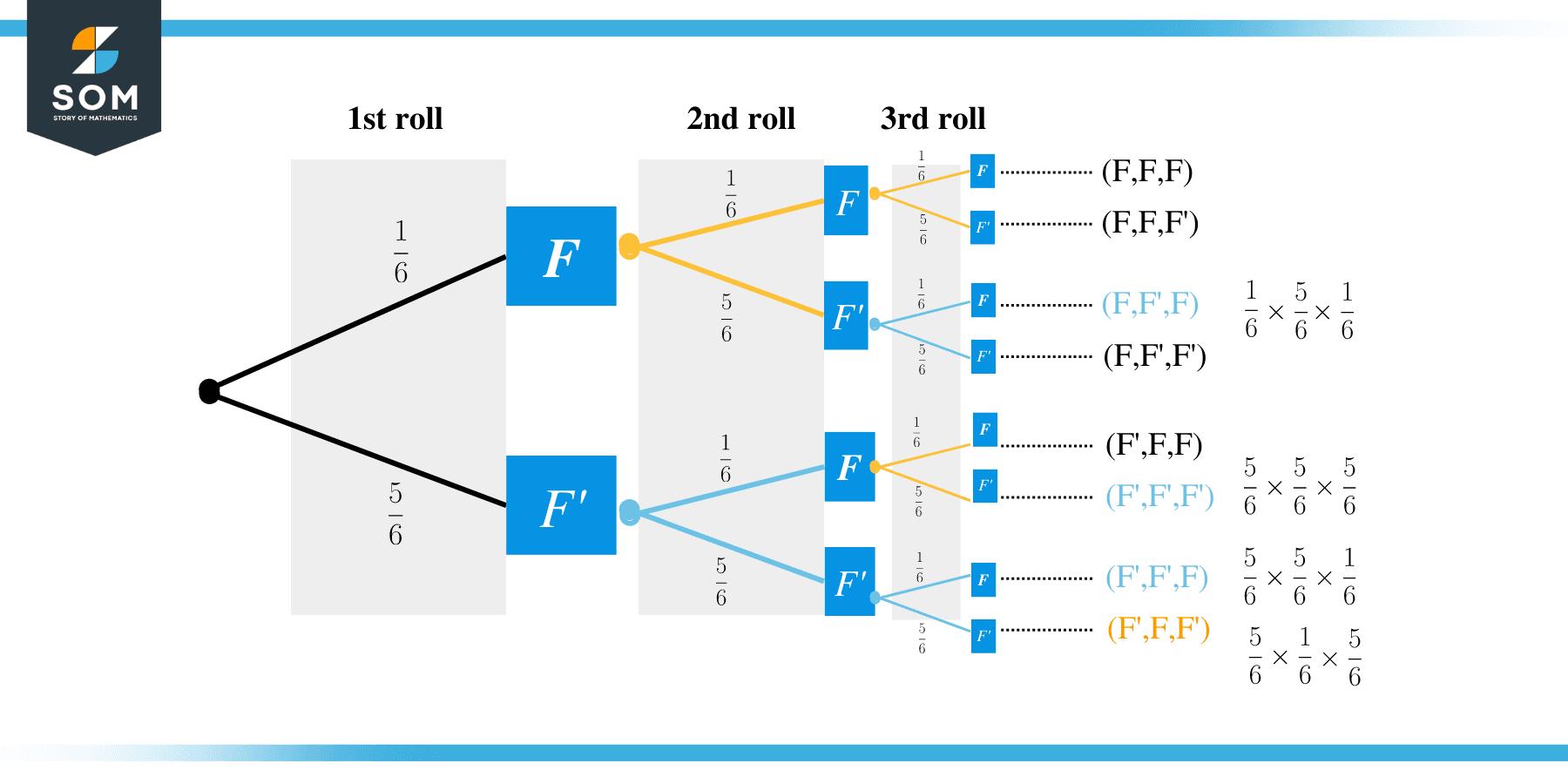 The event that no four appears in all three attempts is highlighted in red in the tree diagram. We calculate the probability as follows:$P(F’F’F’)=\frac56 \times \frac56 \times \frac56=\frac{125}{216}$.There are three branches in the tree diagram (highlighted in blue) that correspond to the event that only one four appears in three attempt. The corresponding probability is calculated as$P(\textrm{One four in three attempts}) = P(FF’F’) + P(F’FF’) + P(F’F’F)$$\qquad \qquad \qquad \qquad \qquad \qquad \quad = (\frac56 \times \frac56 \times \frac16)+(\frac56 \times \frac56 \times \frac16)+(\frac56 \times \frac56 \times \frac16)=\frac{125}{216}$.Example 9: A single die is rolled twice. Find the probability of the following events using a tree diagram.
The event that no four appears in all three attempts is highlighted in red in the tree diagram. We calculate the probability as follows:$P(F’F’F’)=\frac56 \times \frac56 \times \frac56=\frac{125}{216}$.There are three branches in the tree diagram (highlighted in blue) that correspond to the event that only one four appears in three attempt. The corresponding probability is calculated as$P(\textrm{One four in three attempts}) = P(FF’F’) + P(F’FF’) + P(F’F’F)$$\qquad \qquad \qquad \qquad \qquad \qquad \quad = (\frac56 \times \frac56 \times \frac16)+(\frac56 \times \frac56 \times \frac16)+(\frac56 \times \frac56 \times \frac16)=\frac{125}{216}$.Example 9: A single die is rolled twice. Find the probability of the following events using a tree diagram.- Getting no odd number.
- Getting at most one odd number.
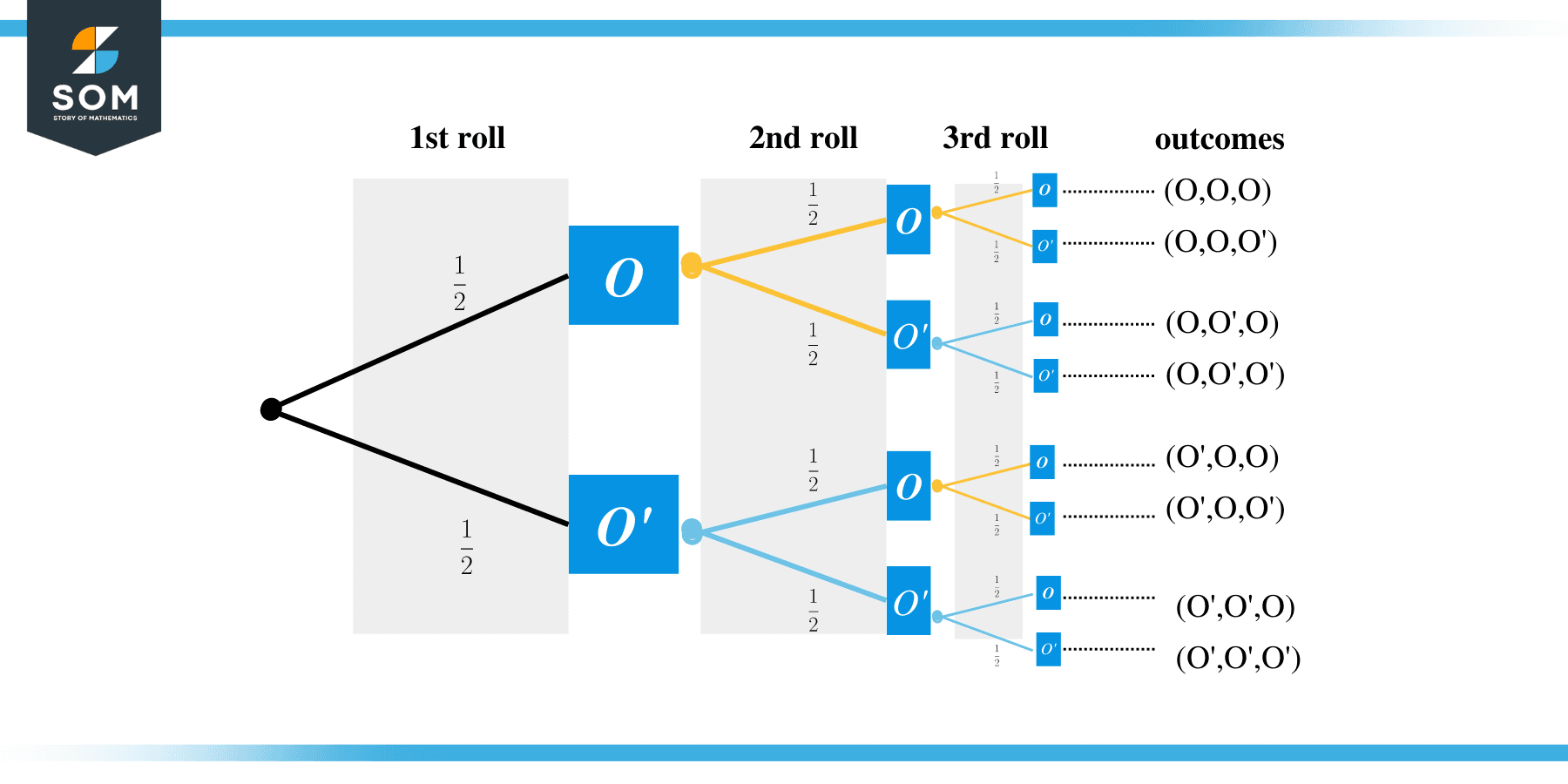
- We can see from the tree diagram that the probability of getting no odd number is
Multiple dice and independent events:
Two events are said to be independent if one experiment’s outcome does not affect the other event’s probabilities. For example, when we roll a die twice, both rolls are independent events as the first roll’s outcome does not affect the second roll’s probability and vice versa. Remember from the basic probability theory that when two events, say $E1$ and $E2$, are independent, the probability of getting $E1$ AND $E2$ is$P(\textrm{E1 and E2})=P(E1) \times P(E2)$ .
We can use the formula for probabilities of independent events to calculate probabilities of multiple rolls of dice without relying on the sample space, as we show in the following examples:Example 10: When we roll two dice simultaneously, the probability that the first roll is $2$ and the second is $6$.Solution:$P( \textrm{First roll is 2}) = \frac{1}{6}$.$P( \textrm{Second roll is 6}) = \frac{1}{6}$.$P(\textrm{First roll 2 and Second roll 6}) = P( \textrm{First roll is 2}) \times P( \textrm{Second roll is 6}) = \frac{1}{36}$.Example 11: Two six-sided, fair dice are rolled. What are the probabilities of getting one even and one odd number?Solution:We have already solved this problem using the sample space method. Now, let’s solve it using the independent probability formula.Since we are interested in one even and one odd, there are two possibilities when two dice are rolled,- The first roll gives an even number and the second roll is odd
- The second is even, and the first is odd.
Practice Questions:
- What is the probability of getting a number at least 5 or greater when a fair six-sided die is rolled?
- What is the probability of getting 1 or 5 when a fair six-sided die is rolled?
- We roll two dice simultaneously, what is the probability of the following events:
a) getting sum divisible by 6.
b) getting a total of at least 9.
c) getting sum ≤ 4.
d) getting a doublet of odd numbers.
4.We roll a single die three times. Find the probability of the following events using a tree diagram:
a) getting an even number in all three attempts.
b) getting at least two even numbers in three attempts.
Answer Key:
1)$\frac{1}{3}$.2) $\frac{1}{3}$.3) a.$\frac{1}{6}$.b.$\frac{5}{18}$.c.$\frac{1}{6}$.d.$\frac{1}{12}$.4) ‘E’ represents even numbers and E’ represents not an even number.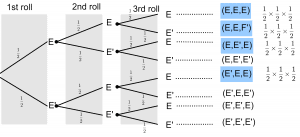 a).$\frac18$.b).$\frac38$
a).$\frac18$.b).$\frac38$